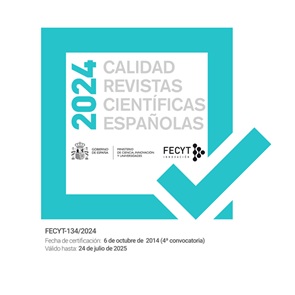El Carnaval de los cuerpos. El desafío simbólico y político del trans-vestismo
Resumen
Esta contribución investiga el travestismo, entendido como una constante cultural y como un desafío simbólico y político a las indentidad del género. A partir de las reflexiones de Judith Butler, el travestismo será analizado de acuerdo con tres aspectos: una inversion estética, un acto performativo y una subversión semántica.
This paper discusses cross-dressing as a cross-cultural phenomenon and as a symbolic and political challenge to gender’s identity as well. Starting from Judith Butler’s works, the drag will be analyzed in accordance with three different aspects: an aesthetic inversion, a performative act and a semantic turn.
Descargas
-
Resumen595
-
PDF1294
Citas
BAJTIN, Mijail (1965, 2003): La cultura popular en la edad media y en el renacimiento, trad. cast. de J. Forcat y C. Conroy, Alianza, Madrid.
BALDINI, Costanza (eds.) (2008): Sociologia della moda, Armando, Roma.
BARNES, Ruth y EICHER, Joanne B. (eds.) (1992): Dress and gender making and meaning, Berg, Oxford.
BARTHES, Roland (1967): Système de la mode, Seuil, Paris.
BUTLER, Judith (1993): Bodies that matter, Routledge, New York.
BUTLER, Judith (2004): Undoing Gender, Routledge, New York.
BUTLER, Judith (2006): Gender Trouble, 2 ed., Routledge, New York.
CRAWLEY, Alfred E. (Juno 1893): «Achilles at Skyros», The Classical Review, n° 6, pp. 243–45.
CRAWLEY, Alfred E. (Juno 1895): «Sexual Taboo: a study in the relations of the sexes», Journal of the Anthropological Institute, n° 24, pp. 116–25.
DE LAURETIS, Teresa (1996): Sui generis. Scritti di teoria femminista, Feltrinelli, Milano:
DEKKER, Rudolf M. y VAN DEL POL, Lotte (eds.) (1989): The tradition of female transvestitism in the early modern Europe, Macmillan Press, Basingstoke.
DEVOR, Holly (1999): FTM: Female-to-Male Transsexuals in Society, Indiana, Indiana University Press, 1999.
DOUGLAS, Mary (1966, 2002): Purity and Danger. An Analysis of Concepts of Pollution and Taboo, Routledge, New York.
EKINS, Richard (1997): Male femaling. A grounded theory approach to cross-dressing and sex-changing, Routledge, New York.
EKINS, Richard y KING, David (eds.) (1996): Blending genders. Social aspects of cross-dressing and sex-changing, Routledge, New York.
EPSTEIN, Julia y STRAUB, Kristina (eds.) (1991): Bodyguards: the cultural politics of gender ambiguity, Routledge, New York.
FOUCAULT, Michel (1976): La volonté de savoir, Gallimard, Paris.
FOUCAULT, Michel (1976): Historie de la sexualité, Gallimard, Paris.
FRAZER, James (1915): The golden bough. A study in magic and religion, Macmillan, New York.
GARBER, Marjorie (1992): Vested interests. Cross-dressing and cultural anxiety, Routledge, New York.
HALLETT, Judith P. y SKINNER, Marilyn B. (eds.) (1997): Roman sexualities, University Press, Princeton.
HIRSCHFELD, Magnus (1910): Die Transvestiten: Eine Untersuchung über den erotischen Verkleidungstrieb, mit umfangreichem kasuistischem und historischem Material, Verlag Alfred Pulvermacher, Berlin.
NEWTON, Esther (1972): Mother Camp. Female Impersonators in America, Chicago.
PENNER, Todd y VANDER STICHELE, Caroline (2007): Mapping gender in ancient religious discourses, Brill, Leiden-Boston.
STORR, Anthony (1991): «The Psychopathology of Fetischism and Transvestitism», en SAMUELS, Andrew (eds.): Psychopathology: contemporary Jungian perspectives, The Guilford Press, New York, pp. 255-274.
SUMMERS, Claude J. (eds.) (2004): The queer Encyclopedia of the visual arts, Cleis, San Francisco.
VON HUMBOLDT, Wilhelm (1836): Über die Verschiedenheit des menschliches Sprachbaues, Akademie, Berlin.
WHEELWRIGHT, Julie (1989): Amazons and military maids: women who dressed as men in the pursuit of life, liberty and happiness, Pandora Press, London.
ZEITLIN, Froma I., WINKER, John J. & HALPERIN, David M. (eds.) (1991): Before sexuality. The construction of erotic experience in the ancient Greek world, University Press, Princeton.
Las obras que se publican en esta revista están sujetas a los siguientes términos:
1. El Servicio de Publicaciones de la Universidad de Murcia (la editorial) conserva los derechos patrimoniales (copyright) de las obras publicadas, y favorece y permite la reutilización de las mismas bajo la licencia de uso indicada en el punto 2.
2. Las obras se publican en la edición electrónica de la revista bajo una licencia Creative Commons Reconocimiento-NoComercial-SinObraDerivada 3.0 España (texto legal). Se pueden copiar, usar, difundir, transmitir y exponer públicamente, siempre que: i) se cite la autoría y la fuente original de su publicación (revista, editorial y URL de la obra); ii) no se usen para fines comerciales; iii) si remezcla, transforma o crea a partir del material, no podrá distribuir el material modificado.
3. Condiciones de auto-archivo. Se permite y se anima a los autores a difundir electrónicamente las versiones pre-print (versión antes de ser evaluada) y/o post-print (versión evaluada y aceptada para su publicación) de sus obras antes de su publicación, ya que favorece su circulación y difusión más temprana y con ello un posible aumento en su citación y alcance entre la comunidad académica. Color RoMEO: verde.










